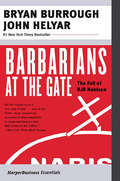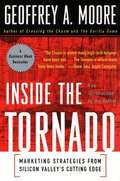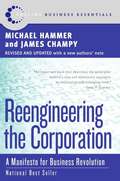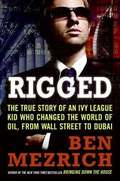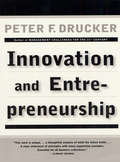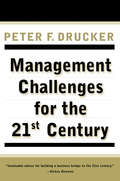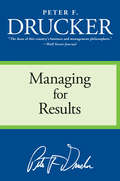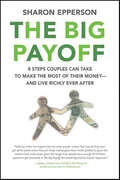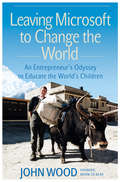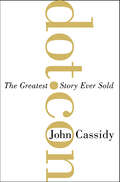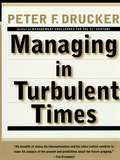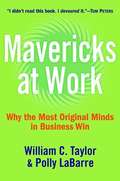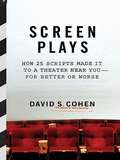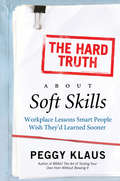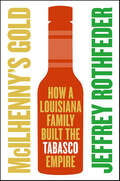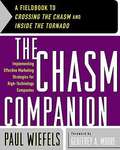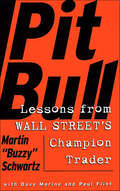- Table View
- List View
Barbarians at the Gate: The Fall of RJR Nabisco
by Bryan Burrough John HelyarBarbarians at the Gate has been called one of the most influential business books of all time -- the definitive account of the largest takeover in Wall Street history. Bryan Burrough and John Helyar's gripping account of the frenzy that overtook Wall Street in October and November of 1988 is the story of deal makers and publicity flaks, of strategy meetings and society dinners, of boardrooms and bedrooms -- giving us not only a detailed look at how financial operations at the highest levels are conducted but also a richly textured social history of wealth at the twilight of the Reagan era. Barbarians at the Gate -- a business narrative classic -- is must reading for everyone interested in the way today's world really works.
The Forgotten Man: A New History of the Great Depression
by Amity ShlaesAmity Shlaes, one of the nation's most-respected economic commentators, offers a striking reinterpretation of the Great Depression. She traces the mounting agony of the New Dealers and the moving stories of individual citizens who through their brave perseverance helped establish the steadfast character we recognize as American today.
The Forgotten Man
by Amity ShlaesIn The Forgotten Man, Amity Shlaes, one of the nation's most-respected economic commentators, offers a striking reinterpretation of the Great Depression. She traces the mounting agony of the New Dealers and the moving stories of individual citizens who through their brave perseverance helped establish the steadfast character we recognize as American today.
Inside the Tornado
by Geoffrey A. MooreIn this, the second of Geoff Moore's classic three-part marketing series, Moore provides highly useful guidelines for moving products beyond early adopters and into the lucrative mainstream market. Updated for the HarperBusiness Essentials series with a new author's note. Once a product "crosses the chasm" it is faced with the "tornado," a make or break time period where mainstream customers determine whether the product takes off or falls flat. In Inside the Tornado, Moore details various marketing strategies that will teach marketers how reach these customers and how to take advantage of living inside the tornado in order to reap the benefits of mainstream adoption.
Inside the Tornado: Strategies for Developing, Leveraging, and Surviving Hypergrowth Markets
by Geoffrey A. MooreIn this, the second of Geoff Moore's classic three-part marketing series, Moore provides highly useful guidelines for moving products beyond early adopters and into the lucrative mainstream market. Updated for the HarperBusiness Essentials series with a new author's note.Once a product "crosses the chasm" it is faced with the "tornado," a make or break time period where mainstream customers determine whether the product takes off or falls flat. In Inside the Tornado, Moore details various marketing strategies that will teach marketers how reach these customers and how to take advantage of living inside the tornado in order to reap the benefits of mainstream adoption.
Reengineering the Corporation
by Michael Hammer James ChampyThe most successful business book of the last decade, Reengineering the Corporation is the pioneering work on the most important topic in business today: achieving dramatic performance improvements. This book leads readers through the radical redesign of a company's processes, organization, and culture to achieve a quantum leap in performance. Michael Hammer and James Champy have updated and revised their milestone work for the New Economy they helped to create -- promising to help corporations save hundreds of millions of dollars more, raise their customer satisfaction still higher, and grow ever more nimble in the years to come.
Rigged: The True Story of an Ivy League Kid Who Changed the World of Oil, from Wall Street to Dubai
by Ben MezrichFrom the author who brought you the massive New York Times bestseller Bringing Down the House, this is the startling rags-to-riches story of an Italian-American kid from the streets of Brooklyn who claws his way into the wild, frenetic world of the oil exchange. After conquering the hallowed halls of Harvard Business School, he enters the testosterone-laced warrens of the Merc Exchange, the asylumlike oil exchange located in lower Manhattan. A place where billions of dollars trade hands every week, the Merc is like a casino on crack, where former garbagemen become millionaires overnight and where fistfights break out on the trading floor. This ordinary kid has traded Brooklyn for the gold-lined hotel palaces of Dubai. He keeps company on the decks of private yachts in Monte Carlo-teeming with half-naked girls flown in by Saudi sheiks-and makes deals in the dangerous back alleys of Beijing. But the Merc is just a starting place. Taken under the wing of another young gun and partnering with a mysterious young Muslim, the kid embarks on a dangerous adventure to revolutionize the oil trading industry-and, along with it, the world. Rigged is the explicit, exclusive, true story behind the headlines that dominate the world stage.
Innovation and Entrepreneurship
by Peter F. DruckerPeter Drucker's classic book on innovation and entrepreneurship This is the first book to present innovation and entrepreneurship as a purposeful and systematic discipline that explains and analyzes the challenges and opportunities of America's new entrepreneurial economy. Superbly practical, Innovation and Entrepreneurship explains what established businesses, public service institutions, and new ventures need to know and do to succeed in today's economy.
MANAGEMENT CHALLENGES for the 21st Century
by Peter F. DruckerPeter F. Drucker discusses how the new paradigms of management have changed and will continue to change our basic assumptions about the practices and principles of management. Forward-looking and forward-thinking, Management Challenges for the 21st Century combines the broad knowledge, wide practical experience, profound insight, sharp analysis, and enlightened common sense that are the essence of Drucker's writings and "landmarks of the managerial profession." --Harvard Business Review
Managing for Results
by Peter F. DruckerThe effective business, Peter Drucker observes, focuses on opportunities rather than problems. How this focus is achieved in order to make the organization prosper and grow is the subject of this companion to his classic work, The Practice of Management. Managing for Results shows what the executive decision maker must do to move his enterprise forward. Drucker again employs his particular genius for breaking through conventional outlooks and opening up new perspectives for profits and growth.
Roasting in Hell's Kitchen: Temper Tantrums, F Words, and the Pursuit of Perfection
by Gordon RamsayEveryone thinks they know the real Gordon Ramsay: rude, loud, pathologically driven, stubborn as hellFor the first time, Ramsay tells the full inside story of his life and how he became the world's most famous and infamous chef: his difficult childhood, his brother's heroin addiction, his failed first career as a soccer player, his fanatical pursuit of gastronomic perfection and his TV persona—all of the things that made him the celebrated culinary talent and media powerhouse that he is today. In Roasting in Hell's Kitchen Ramsay talks frankly about his tough and emotional childhood, including his father's alcoholism and violence and their effect on his relationships with his mother and siblings. His rootless upbringing saw him moving from house to house and town to town followed by the authorities and debtors as his father lurched from one failed job to another. He recounts his short-circuited career as a soccer player, when he was signed by Scotland's premier club at the age of fifteen but then, just two years later, dropped out when injury dashed his hopes. Ramsay searched for another vocation and, much to his father's disgust, went into catering, which his father felt was meant for “poofs.”He trained under some of the most famous and talented chefs in Europe, working to exacting standards and under extreme conditions that would sometimes erupt in physical violence. But he thrived, with his exquisite palate, incredible vision and relentless work ethic. Dish by dish, restaurant by restaurant, he gradually built a Michelin-starred empire.A candid, eye-opening look into the extraordinary life and mind of an elite and unique restaurateur and chef, Roasting in Hell's Kitchen will change your perception not only of Gordon Ramsay but of the world of cuisine.
The Big Payoff: 8 Steps Couples Can Take to Make the Most of Their Money—and Live Richly Ever After
by Sharon EppersonMiddle-class couples are working harder than ever. So why are they finding it more difficult to finance their homes, send their kids to college, and save toward retirement?Couples who are strapped for time and weighed down by costly fixed expenses need more than a personal finance pep talk: They need a plan. In The Big Payoff, CNBC correspondent Sharon Epperson lays out a nuts-and-bolts program that couples of all ages can use to realize their financial dreams. From stretching your budget and investing wisely in your home to protecting your family's money and building wealth over the years, The Big Payoff offers a concise bounty of precious information and practical steps toward financial wellness.Epperson begins by showing couples how to communicate better about money. She helps them realize that the same qualities needed to create a lasting relationship—understanding, compromise, and patience—are vital when it comes to building a secure financial future. Every important decision couples make, whether it's buying a home, having kids, changing jobs, or preparing for retirement, will inevitably involve a discussion about money, and Epperson teaches them how to handle finances with a cool hand while keeping the marriage vibrant and healthy. In addition, she empowers couples to take money matters into their own hands and shows them that by taking control of their finances, they can stop fretting about cash and start focusing on the important things in life.Each of the following chapters is designed to get partners talking and thinking about their financial life together. In eight easy-to-understand steps, Epperson unpacks the various options for saving money; creating emergency, retirement, and college savings plans; investing in a home; choosing the right life and health insurance; and drafting an estate plan. A wife and mother of two herself, Epperson knows a thing or two about the pitfalls of financial planning and doses her advice with plenty of humorous anecdotes, hard-earned experience, and down-to-earth language. Additionally, through helpful worksheets and exercises, The Big Payoff helps readers customize a plan that will work best for them and reap the most payback.It's never too late or too early to start, and now is the best time to start planning. Whether you are newlyweds or fast-approaching retirement, just starting a family or soon to be empty-nesters, this book is for you. After working hard to provide for your family, the reward of discovering your financial strength will be the peace of mind to enjoy your marriage, your family, and the rest of your lives together.
Leaving Microsoft to Change the World
by John WoodJohn Wood discovered his passion, his greatest success, and his life's work not at business school or helping lead Microsoft's charge into Asia in the 1990s but on a soul-searching trip to the Himalayas. He made the difficult decision to walk away from his lucrative career to create Room to Read, a nonprofit organization that promotes education across the developing world. By the end of 2007, the organization will have established over 5,000 libraries and 400 schools, and awarded long-term scholarships to more than 3,000 girls, giving more than one million children the lifelong gift of education. If you have ever pondered abandoning your desk job for an adventure and an opportunity to give back, Wood's story will inspire you. He offers a vivid, emotional, and absorbing tale of how to take the lessons learned at a hard-charging company like Microsoft and apply them to the world's most pressing social problems.
Leaving Microsoft to Change the World
by John WoodJohn Wood discovered his passion, his greatest success, and his life's work not at business school or helping lead Microsoft's charge into Asia in the 1990s but on a soul-searching trip to the Himalayas. He made the difficult decision to walk away from his lucrative career to create Room to Read, a nonprofit organization that promotes education across the developing world. By the end of 2007, the organization will have established over 5,000 libraries and 400 schools, and awarded long-term scholarships to more than 3,000 girls, giving more than one million children the lifelong gift of education. If you have ever pondered abandoning your desk job for an adventure and an opportunity to give back, Wood's story will inspire you. He offers a vivid, emotional, and absorbing tale of how to take the lessons learned at a hard-charging company like Microsoft and apply them to the world's most pressing social problems.
Dot.Con: The Greatest Story Ever Sold
by John CassidyThe Internet stock bubble wasn't just about goggle-eyed day traderstrying to get rich on the Nasdaq and goateed twenty-five-year-olds playing wannabe Bill Gates. It was also about an America that believed it had discovered the secret of eternal prosperity: it said something about all of us, and what we thought about ourselves, as the twenty-first century dawned. John Cassidy's Dot.con brings this tumultuous episode to life. Moving from the Cold War Pentagon to Silicon Valley to Wall Street and into the homes of millions of Americans, Cassidy tells the story of the great boom and bust in an authoritative and entertaining narrative. Featuring all the iconic figures of the Internet era -- Marc Andreessen, Jeff Bezos, Steve Case, Alan Greenspan, and many others -- and with a new Afterword on the aftermath of the bust, Dot.con is a panoramic and stirring account of human greed and gullibility.
Managing In Turbulent Times
by Peter F. DruckerThis book, the author explains, "is concerned with action rather than understanding, with decisions rather than analysis." It deals with the strategies needed to transform rapid changes into opportunities, to turn the threat of change into productive and profitable action that contributes positively to our society, the economy, and the individual.
Mavericks at Work
by William C. Taylor Polly G. LabarreBusiness as usual is a bust . . . In industry after industry, organizations that were once dismissed as upstarts, wildcards--mavericks--are making serious waves and growing fast. From high-profile innovators such as HBO and Google to funky sandwich shop chains, the truly imaginative and unconventional businesses are changing the way things are done--providing new approaches, strategies, and outlooks, as well as better ways to compete, lead, and succeed in the twenty-first century. The first book to document this change, Mavericks at Work is business "edutainment" for a smart, ambitious readership, profiling some of the most exciting--and often eccentric--CEOs in the United States, while detailing their remarkable strategies for success
Secrets of Six-Figure Women: Surprising Strategies to Up Your Earnings and Change Your Life
by Barbara Stanny<p>According to the Department of Labor, the average woman in 1998 was bringing home less than $25,000 a year. For every dollar that a man makes, a woman makes between 50 and 75 cents, and that is hardly news. <p>But what you may not know is that, quietly and steadily, the number of women making six figures or more is rapidly increasing. Currently, over fifteen million women make $100,000 or more, and the number continues to rise at a rate faster then for men. And these women come from every industry - psychologists, dot com founders, consultants, freelance writers, and even part-timers. <p>What makes these particular women able to do so well in the workplace? Fueled by curiosity, Barbara Stanny, author of <i>Price Charming Isn't Coming: How Women Get Smart About Money</i>, set out to research this phenomenon. What she discovered was that, though the high-earning women she interviewed came from different backgrounds and had had greatly different work experiences, they all had certain characteristics in common. <p><i>Secrets of Six Figure Woman: Surprising Strategies of the Successful High Earners</i> will be a ground breaking book for high earners who want to ensure their wealth, enhance their success, and learn from others who are in the same boat. It will also offer inspiration, guidance, and motivation to those who aspire to make more.</p>
Screen Plays: How 25 Scripts Made It to a Theater Near You--for Better or Worse
by David S. CohenIn this fascinating survey of contemporary screen craft, David Cohen of Script and Variety magazines leads readers down the long and harrowing road every screenplay takes from idea to script to screen. In interviews with Hollywood screenwriters from across the board-Oscar winners and novices alike-Cohen explores what sets apart the blockbuster successes from the downright disasters. Tracing the fortunes of twenty-five films, including Troy, Erin Brockovich, Lost in Translation, and The Aviator, Cohen offers insider access to back lots and boardrooms, to studio heads, directors, and to the over-caffeinated screenwriters themselves. As the story of each film evolves from the drawing board to the big screen, Cohen proves that how a script is written, sold, developed, and filmed can be just as dramatic and intriguing as the movie itself-especially when the resulting movie is a fiasco. Covering films of all kinds-from tongue-in-cheek romps like John Waters's A Dirty Shame to Oscar winners like Monster's Ball and The Hours-Screen Plays is an anecdote-filled, often inspiring, always revealing look at the alchemy of the movie business. With Cohen as your expert guide, Screen Plays exposes how and why certain films (such as Gladiator) become "tent poles," those runaway successes every studio needs to survive, and others become train wrecks. Full of critical clues on how to sell a script-and avoid seeing it destroyed before the director calls Action!-it's the one book every aspiring screenwriter will find irresistible.
The Hard Truth About Soft Skills: Soft Skills for Succeeding in a Hard Wor
by Peggy KlausWhat's the hard truth? Soft skills get little respect but will make or break your career. Master your soft skills and really get ahead at work! Fortune 500 coach Peggy Klaus encounters individuals every day who excel at their jobs but aren't getting where they want to go. It's rarely a shortfall in technical expertise that limits their careers, but rather a shortcoming in their social, communication, and self-management behaviors. In The Hard Truth About Soft Skills Klaus delivers practical tools and techniques for mastering soft skills across the career spectrum. She shows how to: manage your workload handle the critics develop and promote your personal brand navigate office politics lead the troops and much more! Klaus reveals why soft skills are often ignored, while bringing their importance to life in her trademark style--straightforward, humorous, and motivating. Perfect for readers at all professional stages--from those who are just starting out to seasoned executives--this book is essential reading for anyone who wants to take his or her career to the next level.
Change or Die
by Alan DeutschmanChange or Die. What if you were given that choice? If you didn't, your time would end soon--a lot sooner than it had to. Could you change when change matters most? This is the question Alan Deutschman poses in Change or Die, which began as a sensational cover story by the same title for Fast Company. Deutschman concludes that although we all have the ability to change our behavior, we rarely ever do. From patients suffering from heart disease to repeat offenders in the criminal justice system to companies trapped in the mold of unsuccessful business practices, many of us could prevent ominous outcomes by simply changing our mindset. A powerful book with universal appeal, Change or Die deconstructs and debunks age-old myths about change and empowers us with three critical keys--relate, repeat, and reframe--to help us make important positive changes in our lives. Explaining breakthrough research and progressive ideas from a wide selection of leaders in medicine, science, and business (including Dr. Dean Ornish, Mimi Silbert of the Delancey Street Foundation, Bill Gates, Daniel Boulud, and many others), Deutschman demonstrates how anyone can achieve lasting, revolutionary changes that are positive, attainable, and absolutely vital.
McIlhenny's Gold: How a Louisiana Family Built the Tabasco Empire
by Jeffrey RothfederIn this fascinating history, Jeffrey Rothfeder tells how, from a simple idea—the outgrowth of a handful of peppers planted on an isolated island on the Gulf of Mexico—a secretive family business emerged that would produce one of the best-known products in the world. A delectable and satisfying read for both Tabasco fans and business buffs, McIlhenny's Gold is the untold story of the continuing success of an eccentric, private company; a lively history of one of the most popular consumer products of all times; and an exploration of our desire to test the limits of human tolerance for fiery foods.
The Chasm Companion
by Paul WiefelsIn The Chasm Companion, The Chasm Group's Paul Wiefels presents readers with a new analysis of the ideas introduced in bestselling author Geoffrey Moore's classic books, Crossing the Chasm and Inside the Tornado, and focuses on how to translate these ideas into actionable strategy and implementation programs. This step-by-step fieldbook is organized around three major concepts: how high-tech markets develop, creating market development strategy, and executing go-to-market programs based on the strategy.
Monday Morning Choices
by David CottrellLearn to make the right decisions to achieve greater success Each of us has a different idea of success. Whether you strive for money, power, happiness, or love, your personal choices, the actions you take, and the relationships you choose to invest time and energy in, will determine whether you reach your goals. Internationally recognized leadership coach David Cottrell will show you how to make the right choices, even when they're hard. There are character choices that define the person you will be on the road to success. Cottrell shows you how to make The No-Victim Choice to overcome roadblocks, and The Integrity Choice, to listen to your gut and do the right thing, even when it's not the easiest thing to do. There are action choices you make to continue on your path to success. The Persistence Choice encourages you to bounce back from failure and learn lessons that will lead to your future success. The Do-Something Choice lets you to stop dreaming and start doing the things that will make you happy and successful. Finally, you make investment choices about the people you spend time with and develop relationships with. The Relationship Choice teaches you to invest your time in other successful people in order to contribute to your own future success. Learn to make all these choices and many more in Monday Morning Choices, and find yourself on the fast track to success!
Pit Bull: Lessons from Wall Street's Champion Trader
by Amy Hempel Martin Schwartz Dave Morine Paul Flint“Investors who feel like they have what it takes to trade . . . should read Pit Bull.” —The Wall Street JournalWelcome to the world of Martin “Buzzy” Schwartz, Champion Trader—the man whose nerves of steel and killer instinct in the canyons of Wall Street earned him the well-deserved name “Pit Bull.” This is the true story of how Schwartz became the best of the best, of the people and places he discovered along the way, and of the trader’s tricks and techniques he used to make his millions.“The most entertaining and insightful look at Wall Street since Liar’s Poker.” —Paul Tudor Jones II, founder, Tudor Investment Corporation and the Robin Hood Foundation“An archetypal text, true to life on the Street, destined to be discussed over drinks at trader hangouts after the market closes.” —Kirkus Reviews“Hilarious and eye-opening . . . Pit Bull tells the real deal about life on Wall Street—and how you make money there.” —Martin Zweig, author of Martin Zweig’s Winning on Wall Street
